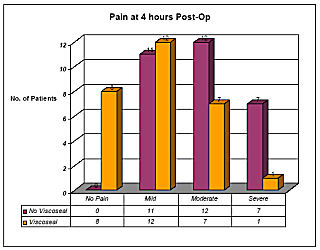Synovial Fluid Replacement in Arthroscopic Shoulder Surgery - A Randomised Controlled Trial
Authors: L Funk & P Wykes
References: Osteoarthritis & Cartilage 2004; 12(Suppl B):126-7
Shoulder arthroscopy has become a widely used procedure for both diagnosis and treatment. It offers less surgical insult than a traditional open approach, with a correspondingly quicker recovery. However it is not an absolutely benign procedure, due both to the effects of the irrigation solution on articular cartilage metabolism as well as post-operative pain, subsequent joint immobilization secondary stiffness.
Viscoseal (TRB Chemedica, AG) is a 0.5% isotonic solution of 1.2 Million Dalton molecular weight hyaluronan. Hyaluronans are a normal proteoglycan component of hyaline cartilage and synovial fluid, and play an important role in joint lubrication and metabolism. Hyaluronan has been proven to have short-term benefits in reducing joint pain and swelling whilst increasing mobility following knee arthroscopy.
The aim of this study was to assess the effect of Viscoseal on the short term outcomes of shoulder arthroscopy.
Materials & Methods
Fifty eight adult patients of the senior author undergoing arthroscopic subacromial decompression were randomised into two groups. The first group received 10 mls of Viscoseal and 10 mls of 0.5% bupivicaine (local anaesthetic) injected into the subacromial bursa via the arthroscope at completion of the procedure (n=28). These patients were controlled by a matched group of patients who received 20 mls of 0.5% bupivicaine only (n=30). All procedures were performed or supervised by the senior author.
Results
The mean age of the viscoseal group was 50.5 years (24-74) and in the control group 48.9 (31-80).
The early post-operative data shows that the Viscoseal group experienced less severe pain 4 hours post-operatively than the control group, with 3.5% of the Viscoseal group experiencing severe pain compared to 23% of the control group. 29% of the patients in the control Viscoseal group felt no pain at 4 hours post-operatively, while none of the patients in the control group had no pain (Figure 1).
The Viscoseal group also required less analgesia post-operatively than the control group. 25% of the Viscoseal required no analgesia, whilst all patients in the control group required analgesia. 33.3% of the control group required opiates compared to 10.7% in the Viscoseal group (Figure 2).
The time to discharge from hospital for the Viscoseal group was 5.2 hours +/-13 hours, and for the control group 9.6 +/- 5.3 hours. This was significantly earlier (p = 0/0001).
There were no adverse events in either group.
Conclusions
Patients receiving injections with Viscoseal felt less post-operative pain and required less post-operative analgesia. They were discharged twice as early as those not getting Viscoseal injections.
Viscoseal seems to have a useful role to play in improving early outcomes after shoulder arthroscopic surgery.
Viscoseal (TRB Chemedica, AG) is a 0.5% isotonic solution of 1.2 Million Dalton molecular weight hyaluronan. Hyaluronans are a normal proteoglycan component of hyaline cartilage and synovial fluid, and play an important role in joint lubrication and metabolism. Hyaluronan has been proven to have short-term benefits in reducing joint pain and swelling whilst increasing mobility following knee arthroscopy.
The aim of this study was to assess the effect of Viscoseal on the short term outcomes of shoulder arthroscopy.
Materials & Methods
Fifty eight adult patients of the senior author undergoing arthroscopic subacromial decompression were randomised into two groups. The first group received 10 mls of Viscoseal and 10 mls of 0.5% bupivicaine (local anaesthetic) injected into the subacromial bursa via the arthroscope at completion of the procedure (n=28). These patients were controlled by a matched group of patients who received 20 mls of 0.5% bupivicaine only (n=30). All procedures were performed or supervised by the senior author.
Results
The mean age of the viscoseal group was 50.5 years (24-74) and in the control group 48.9 (31-80).
The early post-operative data shows that the Viscoseal group experienced less severe pain 4 hours post-operatively than the control group, with 3.5% of the Viscoseal group experiencing severe pain compared to 23% of the control group. 29% of the patients in the control Viscoseal group felt no pain at 4 hours post-operatively, while none of the patients in the control group had no pain (Figure 1).
The Viscoseal group also required less analgesia post-operatively than the control group. 25% of the Viscoseal required no analgesia, whilst all patients in the control group required analgesia. 33.3% of the control group required opiates compared to 10.7% in the Viscoseal group (Figure 2).
The time to discharge from hospital for the Viscoseal group was 5.2 hours +/-13 hours, and for the control group 9.6 +/- 5.3 hours. This was significantly earlier (p = 0/0001).
There were no adverse events in either group.
Conclusions
Patients receiving injections with Viscoseal felt less post-operative pain and required less post-operative analgesia. They were discharged twice as early as those not getting Viscoseal injections.
Viscoseal seems to have a useful role to play in improving early outcomes after shoulder arthroscopic surgery.



